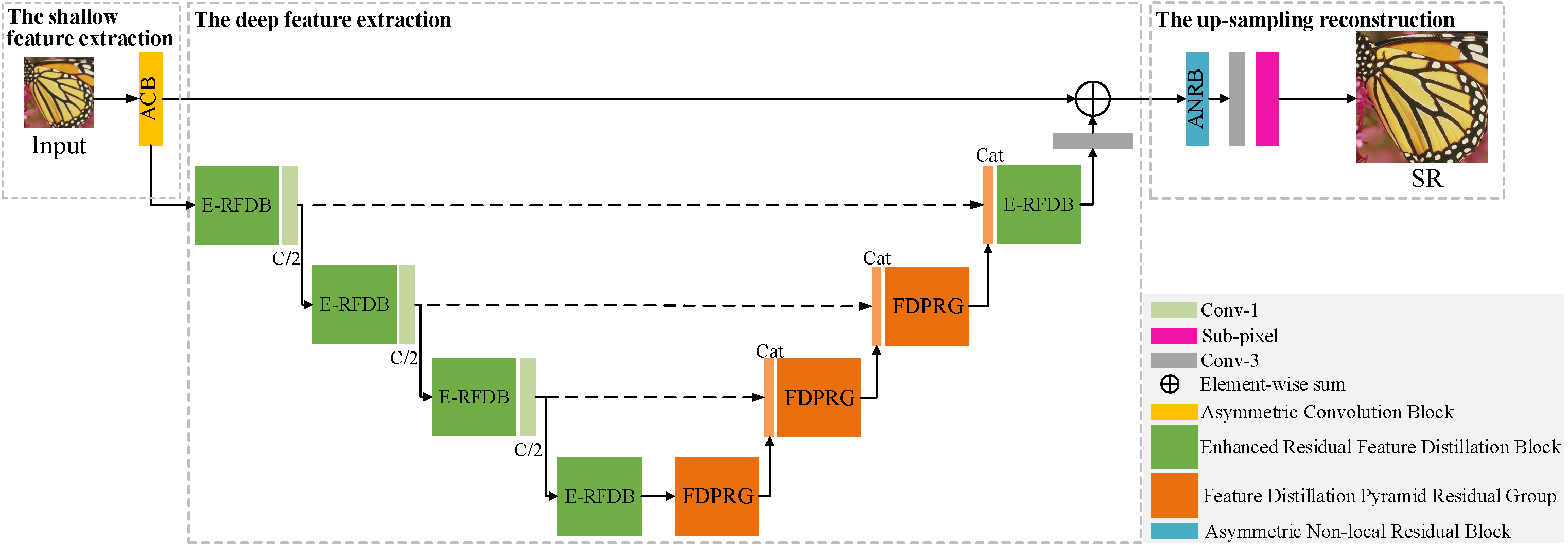This repository is an official PyTorch implementation of the paper "URNet: An U-shaped Residual Network for Lightweight Image Super-resolution"
The code is built on EDSR (PyTorch) .
It is extremely important and necessary for low computing power or portable devices to design more lightweight algorithms for image super-resolution (SR). Recently, most SR methods have achieved outstanding performance by sacrificing computational cost and memory storage, or vice versa. To address this problem, we introduce a lightweight U-shaped Residual Network (URNet) for fast and accurate image SR. Specially, we propose a more effective feature distillation pyramid residual group (FDPRG) to extract features from low-resolution images based on the enhanced residual feature distillation block of E-RFDN. The FDPRG can effectively reuse the learned features with dense shortcut connections and capture multi-scale information with a cascaded feature pyramid block. Based on the U-shaped structure, we utilize a step-by-step fusion strategy to improve the performance of feature fusion of different blocks. This strategy is different from the general SR methods which only use a single Concat operation to fuse the features of all basic blocks. Moreover, a lightweight asymmetric residual non-local block is proposed to model the global context information and further improve the performance of SR. Finally, a high-frequency loss function is designed to alleviate the problem of smoothing image details caused by pixel-wise loss. Extensive experiments show the URNet achieves a better trade-off between image SR performance and model complexity against other state-of-the-art SR methods.
URNet architecture.
We use DIV2K dataset for training and Set5, Set14, B100 and Urban100 dataset for the benchmark test.
-
Prepare training data
Download DIV2K training data (800 training + 100 validtion images) from DIV2K dataset
-
Prepare test data
Test sets are available from benchmark.zip (234M) [BaiduYun, Password: 1234]
For more informaiton, please refer to EDSR (PyTorch).
Unpack the tar/zip file to any place you want. Then, change the dir_data argument in src/option.py to the place where DIV2K/benchmark images are located.
All scripts are provided in the src/demo.sh. Note that URNet (x3, x4) requires pre-trained URNet (x2). You can ignore this constraint by removing --pre_train <x2 model> argument.
Run the script in src folder. Before you run the demo, please uncomment the appropriate line in demo.sh that you want to execute.
cd src # You are now in */URNet/src
sh demo.sh
We provide the pretrained models in pre_trained directory. To test URNet on benchmark dataset:
You can use scripts in file 'URNet/src' to test models for our paper.
# BI, scale 2, 3, 4
# URNet_X2
python main.py --model urn --data_test Set5+Set14+B100+Urban100--scale 2 --pre_train ../pre_trained/urn_x2.pt --test_only --save_results
# URNet_X3
#python main.py --model urn --data_test Set5+Set14+B100+Urban100--scale 3 --pre_train ../pre_trained/urn_x3.pt --test_only --save_results
# URNet_X4
#python main.py --model urn --data_test Set5+Set14+B100+Urban100--scale 4 --pre_train ../pre_trained/urn_x4.pt --test_only --save_resultsYou can use scripts in file 'URNet/src' to test models for our paper.
# URNet model (x2), input=64x64, output=128x128
python main.py --model urn --scale 2 --patch_size 128 --batch_size 32 --save urn_x2 --loss 1.0*L1+0.25*canny --lr 5e-4 --reset
# URNet model (x3) - from URNet (x2), input=64x64, output=192x192
#python main.py --model urn --scale 3 --patch_size 192 --batch_size 32 --save urn_x3 --loss 1.0*L1+0.25*canny --lr 5e-4 --reset --pre_train [pre-trained urn_x2model dir]
# URNet model (x4) - from URNet (x2), input=64x64, output=256x256
#python main.py --model urn --scale 4 --patch_size 256 --batch_size 32 --save urn_x4 --loss 1.0*L1+0.25*canny --lr 5e-4 --reset --pre_train [pre-trained urn_x2 model dir]| Network | Parameters | Set5 | Set14 | B100 | Urban100 |
|---|---|---|---|---|---|
| URNet_x2 | 612K | 38.06/0.9608 | 33.68/0.9187 | 32.24/0.9005 | 32.42/0.9310 |
| URNet_x3 | 621K | 34.51/0.9281 | 30.40/0.8433 | 29.14/0.8061 | 28.40/0.8574 |
| URNet_x4 | 633K | 32.20/0.8952 | 28.63/0.7826 | 27.60/0.7369 | 26.23/0.7905 |
We provide our results on four benchmark dataset (Set5, Set14, B100 and Urban100). URNet_results.zip (381M) [BaiduYun, Password: 1234]
This code is built on EDSR (PyTorch). We thank the authors for sharing their codes of EDSR Torch version and PyTorch version.
